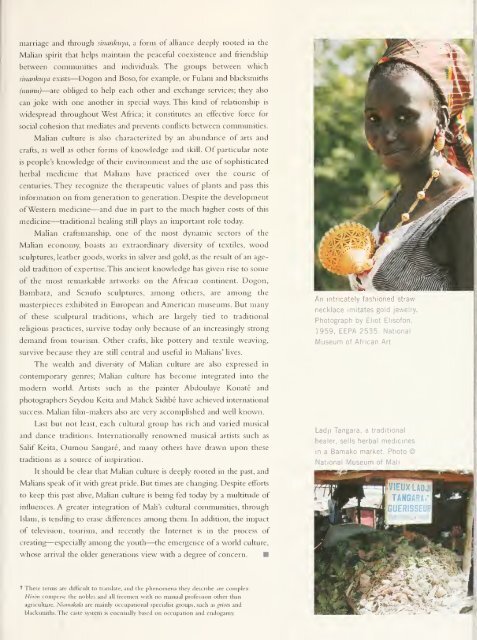SCOTLAND - Smithsonian Digital Repository - Smithsonian Institution
SCOTLAND - Smithsonian Digital Repository - Smithsonian Institution
SCOTLAND - Smithsonian Digital Repository - Smithsonian Institution
Create successful ePaper yourself
Turn your PDF publications into a flip-book with our unique Google optimized e-Paper software.
marriage and through sinankuya, a form of alliance deeply rooted m the<br />
Malian spirit that helps maintain the peaceflil coexistence and friendship<br />
between communities and individuals. The groups between which<br />
sinankuya exists—Dogon and Boso, for example, or Fulani and blacksmiths<br />
(numu)—are obliged to help each other and exchange services; they also<br />
can joke with one another in special ways. This kind of relationship is<br />
widespread throughout West Africa; it constitutes an efiective force for<br />
social cohesion that mediates and prevents conflicts between communities.<br />
Malian culture is also characterized by an abundance of arts and<br />
crafts, as well as other forms of knowledge and skill. Of particular note<br />
is<br />
people's knowledge of their environment and the use of sophisticated<br />
herbal medicine that Malians have practiced over the course of<br />
centuries. They recognize the therapeutic values of plants and pass this<br />
information on from generation to generation. Despite the development<br />
ofWestern medicine—and due in part to the much higher costs of this<br />
medicine—traditional healing still plays an important role today.<br />
Malian craftsmanship, one of the most dynamic sectors of the<br />
Malian economy, boasts an extraordinary diversity of textiles, wood<br />
sculptures, leather goods, works in silver and gold, as the result of an ageold<br />
tradition of expertise. This ancient knowledge has given rise to some<br />
of the most remarkable artworks on the African continent. Dogon,<br />
Bambara, and Senufo sculptures, among others, are among the<br />
masterpieces exhibited in European and American museums. But many<br />
of these sculptural traditions, which are largely tied to traditional<br />
religious practices, survive today only because of an increasingly strong<br />
demand from tourism. Other crafts, like pottery and textile weaving,<br />
survive because they are still central and useful in Malians' lives.<br />
An intricately fashioned straw<br />
necklace imitates gold jewelry.<br />
Photograph by Eliot<br />
Elisofon,<br />
1959, EEPA 2535. National<br />
Museum of African Art<br />
The wealth and diversity of Mahan culture are also expressed in<br />
contemporary genres; Malian culture has become integrated into the<br />
modern world. Artists such as the painter Abdoulaye Konate and<br />
photographers Seydou Keita and MaUck Sidibe have achieved international<br />
success. Malian film-makers also are very accomplished and well known.<br />
Last but not least, each cultural group has rich and varied musical<br />
and dance traditions. InternationaUy renowned musical artists such as<br />
Sahf Keita, Oumou Sangare, and many others have drawn upon these<br />
traditions as a source of inspiration.<br />
It should be clear that Malian culture is deeply rooted in the past, and<br />
Ladji Tangara, a traditional<br />
healer, sells herbal medicines<br />
in a Bamako market. Photo ©<br />
National Museum of<br />
Mali<br />
Malians speak of it with great pride. But times are changing. Despite efforts<br />
to keep this past ahve, Malian culture is being fed today by a multitude of<br />
influences. A greater integration of Mali's cultural communities, through<br />
Islam, is tencling to erase differences among them. In addition, the impact<br />
of television, tourism, and recendy the Internet is in the process of<br />
creating—especially among the youth—the emergence of a world culture,<br />
whose arrival the older generations view with a degree of concern.<br />
t These terms are difficult to translate, and the phenomena they describe are complex.<br />
Horon comprise the nobles and all freemen with no manual profession other than<br />
agriculture. Niamahala are mainly occupational specialist groups, such as griots and<br />
blacksmiths. The caste system is essentially based on occupation and endogamy.
















